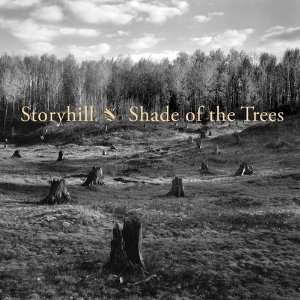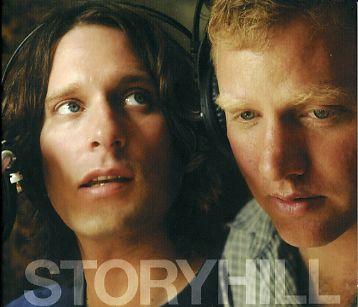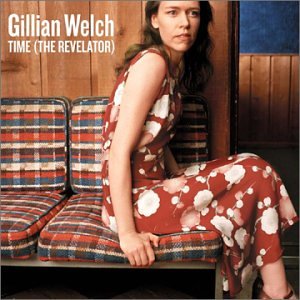
Storyhill “Shade of the Trees” Sessions
Tuesday, July 20th, 2010 | by matthew mcglynn
Here’s your last chance to name the vocal mic used in Storyhill’s fabulous “Dangerous Weapon” video. As promised, I got the inside story on how the acoustic duo’s new album was recorded, from engineer Brad Bivens and producer Dan Wilson.
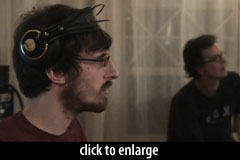 By way of introduction, Brad Bivens is a Nashville-based audio engineer whose credits include Norah Jones and the Kings of Leon. He engineered Storyhill’s Shade of the Trees sessions.
By way of introduction, Brad Bivens is a Nashville-based audio engineer whose credits include Norah Jones and the Kings of Leon. He engineered Storyhill’s Shade of the Trees sessions.
Dan Wilson is a musician and producer from Minneapolis. He is probably best known for his songwriting work with the Dixie Chicks, which won awards for both Best Song and Best Album at the 2006 Grammys. He produced the two most recent Storyhill albums for Red House Records.
If you haven’t seen the “Dangerous Weapon” video, check it out! It’s a gorgeous song. You’ll thank me after.
Dan Wilson
We used the performance from this clip on the album, and you can hear filmmaker Tommy Stone’s feet creaking on the floorboards more than once…
Dan and Brad were kind enough to not only answer the question I left you hanging with three weeks ago — what’s the vocal mic used in that video? — but also to describe the decidedly nontraditional recording process that led to the new Storyhill album, Shade of the Trees, released just a few months ago.
The exclusive session photos you see here were provided by filmmaker Tommy Stone, who graciously took time away from an overbooked schedule to send some frame-grabs from his behind-the-scenes footage from the Shade of the Trees sessions.
Read on for my interview with Dan and Brad…
The “Dangerous Weapon” video knocked me out. The vocal sound is incredible, especially considering both Chris and John appear to be standing off-axis. The blend of their voices is amazing.
DW: Thanks!
I was hoping to make an album that would sound great in a car stereo but if you played it on a real audiophile system it would sound amazing. And I think that’s what we got.
From the start of the preproduction for Storyhill’s Shade of the Trees, band members Johnny Hermanson and Chris Cunningham and I had decided to make a “live in studio” album — we were fine with edits, but we were not going to do any overdubs or punch-ins. They’d play one or two guitars, depending on the song.
On our last project together, the Storyhill album from a few years ago, there had been a few sections where Chris and John had sung in unison, and I loved their blend, it was like a third guy with a really chorus-y voice. I brought that up as one of my favorite sounds of theirs — it could be a way to vary the vocal sounds we could get. Taking that idea to the maximum as is the tendency, Johnny announced that the two would sing together almost the whole time, either in unison or harmony. Later we added a few short bits of solo singing, which in that context became really dramatic moments.
During our songwriting and tweaking sessions, we’d been listening to Gillian Welch’s Time (the Revelator) for sonic inspiration. I noticed that Johnny’s favorite tracks on that album were all the mono ones. So I had in my mind to create a studio set-up that would make possible a mix of mono and stereo songs on the album, depending on the need.
A lot of the challenge for me in recording and mixing the album was in how to get some sense of variety with this very limited palette. I started to think of “how much stereo” as one of the few tools we would have to vary the sound of the songs. A few of the tracks on the album are completely mono, but most of the mono-sounding tracks actually have a little stereo. It just flowed better for me that way.
BB: Preparing for this new micing technique and for capturing a ‘live’ performance was more involved in the planning and setup stages. The measuring, mic placement, number of mics to use and having everything sonically tested out ahead of time was very important. Johnny and Chris are extremely talented and any number of the first few passes of a song could potentially be the ‘final’ take. Once things were set, very little changed aside from removing a few mics as the session went on.
What were the mics used on “Dangerous Weapon?” Are there more in use that are not shown in the video?
DW: Our set up for the album evolved a bit over the course of the sessions. Basically, we had fewer and fewer mics. At first we had two mono mics, a  Soundelux E47 and a Royer ribbon mic a little farther away. I never used the ribbon and eventually we took it down. On each singer we had an LDC, Johnny had a Soundelux 49 and Chris sang into an AKG C12VR. I love that mic although I’ve heard some quibbles about it. But it’s beaten old Neumanns and a vintage C12 in session A-B tests before (Jacquire King and I were working on a project together and we both chose the VR, so it ain’t just my ears.) So there’s got to be something to it.
Soundelux E47 and a Royer ribbon mic a little farther away. I never used the ribbon and eventually we took it down. On each singer we had an LDC, Johnny had a Soundelux 49 and Chris sang into an AKG C12VR. I love that mic although I’ve heard some quibbles about it. But it’s beaten old Neumanns and a vintage C12 in session A-B tests before (Jacquire King and I were working on a project together and we both chose the VR, so it ain’t just my ears.) So there’s got to be something to it.
We also had  Neumann KM 184‘s on the acoustic guitars. Johhny and Chris both sing louder than they play, and it seemed like no matter how carefully we placed one mono mic, we couldn’t get enough guitar and maintain a great vocal tone. So those were there to beef up the acoustic guitars if necessary.
Neumann KM 184‘s on the acoustic guitars. Johhny and Chris both sing louder than they play, and it seemed like no matter how carefully we placed one mono mic, we couldn’t get enough guitar and maintain a great vocal tone. So those were there to beef up the acoustic guitars if necessary.
BB: Simultaneous vocal and acoustic micing is probably one of the harder feats to pull off in the studio, especially when the artist is standing. The likelihood that they may stray from either mic causing varying phase is much greater (even more so if they aren’t hearing the sonic change through headphones). Johnny and Chris, having such powerful voices, forced the KM184’s to be very close to their guitars. This added to the potential for sonic variance. As they are veteran musicians, it wasn’t hard to get them to remain in the sweet spot.
DW: We also put up two Hamptone LDC’s, similar to C12s, near the ceiling about 6 feet in front of the guys and 10 feet apart. Brad can check my memory on that.
BB: The far mics were approximately 8 feet away, 8 feet apart and 6 1/2 feet off the ground. We did about 2/3 of the album in a first session and came back at a later date for the rest, so all mic distances and angles were notated. I probably could have made a three dimensional model of them performing with all the measurements taken. Peter Jackson would have been envious.
DW: Brad engineered the tracking of the record and we both learned a lot as we went along. Brad and I carefully measured the individual vocal mics and the individual guitar mics to make sure the pairs were equidistant to the mono mics. This came in handy as during the mix I tried a trick I read about in an Andy Hong article, delaying the mono mic to be in phase with the guitar and vocal spot mics. I was really skeptical about it but when I put the delay on the close mics, the top end of the record suddenly sprang into focus. It was beautiful.
During the mix I divided the distance between the mics by the speed of sound at our altitude in order to find out how many seconds the sound would take to travel the extra distance…
I am nerdishly proud to share that during the mix I divided the distance between the mics by the speed of sound at our altitude in order to find out how many seconds the sound would take to travel the extra distance. It was some tiny fraction of a second; when I multiplied that by our sample rate, 96,000 samples/second, I got the number of samples delay. I think it was something like 79 samples. But it made a huge difference to the sound. And I enjoyed doing the math.
BB: I enjoyed watching Dan do the math as I share his intrigue for the science as well as the art.
DW: By the time we got to “Dangerous Weapon” there were four mics — the E47 in omni, the on KM184 on John’s guitar, and the two Hamptones. And I think I used only the close mics in the mix, but I’m not sure.
[Brad described the rest of the signal chain; the compressors here were used during tracking: –Ed.]
- Vocal preamps: Manley Voxbox, Neve 1073, Roll Music RMS5A7 “tubule”
- Vocal compressors: Manley Voxbox, LA-2A, Anamod AM660, custom 1176 made with Neve input and output amps (designed by Scott Liebers
- Acoustic guitar preamps/EQ: Vintech x73i
- Acoustic guitar compressor: 1178 in A/B mode
- Ribbon mic preamp: Chandler Germanium
- Preamp for Hamptone mics: Apogee mini-me pre/converter
Using a single vocal mic seems like a dangerous technique when tracks are cheap. What did the centered E47 give you that the individual LDCs didn’t?
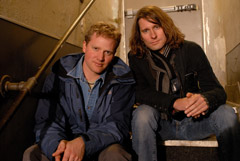 DW: It’s only dangerous if your singers can’t sing. John and Chris have a hair-raising blend live; they have it in the studio, too, and one great mic acts to unify the sound even more. I have a principle to avoid tracking with headphones when possible, so we had to have the guys close together for their blend. Since I had always planned to put the vocals down the middle of the stereo spread, having one mic avoids the slight phase-y effects when two guys are moving around a bit, singing on two mics pretty close to each other.
DW: It’s only dangerous if your singers can’t sing. John and Chris have a hair-raising blend live; they have it in the studio, too, and one great mic acts to unify the sound even more. I have a principle to avoid tracking with headphones when possible, so we had to have the guys close together for their blend. Since I had always planned to put the vocals down the middle of the stereo spread, having one mic avoids the slight phase-y effects when two guys are moving around a bit, singing on two mics pretty close to each other.
Those phase-y effects are all pretty small if you plan to have other instruments in the mix — drums obliterate those subtleties pretty quick. But we were planning to have the guys sing and play together and that would be the album. So I knew that I’d have to deal with that stuff more.
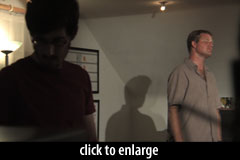 BB: I would agree that having talented artists helps relieve the ever-increasing fear of capturing performances in the moment. Having the pleasure of working with Storyhill on their previous record my mind was at ease striking out in new territory. I was more than excited to follow Dan on his mono mic’ing adventure.
BB: I would agree that having talented artists helps relieve the ever-increasing fear of capturing performances in the moment. Having the pleasure of working with Storyhill on their previous record my mind was at ease striking out in new territory. I was more than excited to follow Dan on his mono mic’ing adventure.
How strong is the temptation to create a sense of stereo when you’re using only mono sources?
DW: Mono doesn’t thrill me in itself, although I remember comparing the mono and stereo mixes of the Beatles “Penny Lane” and being blown away by how much better the mono mix was! This album was really a cool opportunity for me to get to love mono recording and learn about how to use that “middle channel,” as Brian Eno called it.
BB: When mixing mono, depth is your only work space while stereo gives you the luxury of an additional ‘visual field.’ Forcing yourself to be more creative [by] mixing in mono is probably a good exercise for anyone to try. Who knows, maybe you’ll inspire a future Dan Wilson to make a mono record.
Dan, your blog post about this record mentions extensive use of distortion: “just beneath the threshold of hearing, applied liberally and with variety.” Can you elaborate?
 DW: I wanted this album to feel super-intimate and close-up to John and Chris, so I wanted a feeling of clarity and documentary realness. My vision was that the record should sound as if they guys had opened up their laptop and sang and played directly into it. But it would be an “audiophile laptop.” The problems with really recording into a laptop are that the mics on the laptops sound terrible and the hard drive noise and fan noise compete viciously with the actual sound of the music.
DW: I wanted this album to feel super-intimate and close-up to John and Chris, so I wanted a feeling of clarity and documentary realness. My vision was that the record should sound as if they guys had opened up their laptop and sang and played directly into it. But it would be an “audiophile laptop.” The problems with really recording into a laptop are that the mics on the laptops sound terrible and the hard drive noise and fan noise compete viciously with the actual sound of the music.
I realized a few years ago that the recordings that audiophiles love and consider clean are actually not clean at all; they’re always dirtied up by lots of passes through amplifying tubes. Clean recordings sound “digital” to them.
Well, the whole Shade of the Trees album was recorded at 24bit/96K on ProTools, so there was plenty of detail and clean tone. I mixed the record “in the box” using hardware inserts. During the mix I kept feeling the need for less clean tone and more blend.
By the time the mix was done I was using the Phoenix on nearly every track of every song.
I like Cranesong’s Phoenix plug-in, which I think started out as a tape emulator but is more of a subtle distortion/compression to me. By the time the mix was done I was using the Phoenix on nearly every track of every song, and not just a little.
Also, since there were so few tracks on most of the songs, I was able to run a lot of them through one tube-amped compressor or another, all of them working hard enough to sizzle a little bit. On some songs, I bussed the mono mic and individual vocal mics through an old LA2A that a friend lent me; on other songs, the mono mic went through the compressor and output tube of a Manley VoxBox. Both of those compressors have a beautiful overdriven sound when they’re run loud.
On the songs where I used individual vocal mics, I ran each through its own AnaMod 660 compressor, then bussed them along with the mono mic into a tube compressor. The AnaMods are solid-state but they’re trying to emulate tubes, which gives yet another kind of nice distortion that you can hear if you listen really close.
Many thanks to Dan and Brad for their insights into the making of this record, and to Tommy Stone for the session photos and general enthusiasm. For more, check out Tommy’s new video of Dan Wilson, and the catchy new Luke Reynolds CD that Brad engineered. Needless to say, keep your eyes — and ears — on Storyhill too.
Fans of organic music like this will probably enjoy my visit to Frogville Studios in Santa Fe… I haven’t been there for two years, but every time I spin Never Settle For Less it feels like I’m right back there again.
Posted in Interviews, Microphones, Technique | No Comments »
